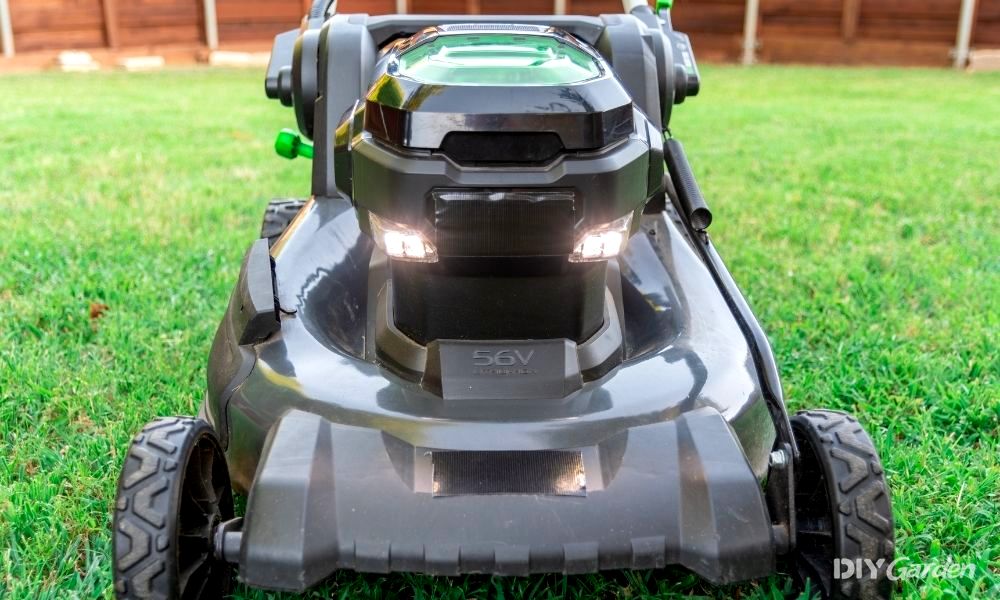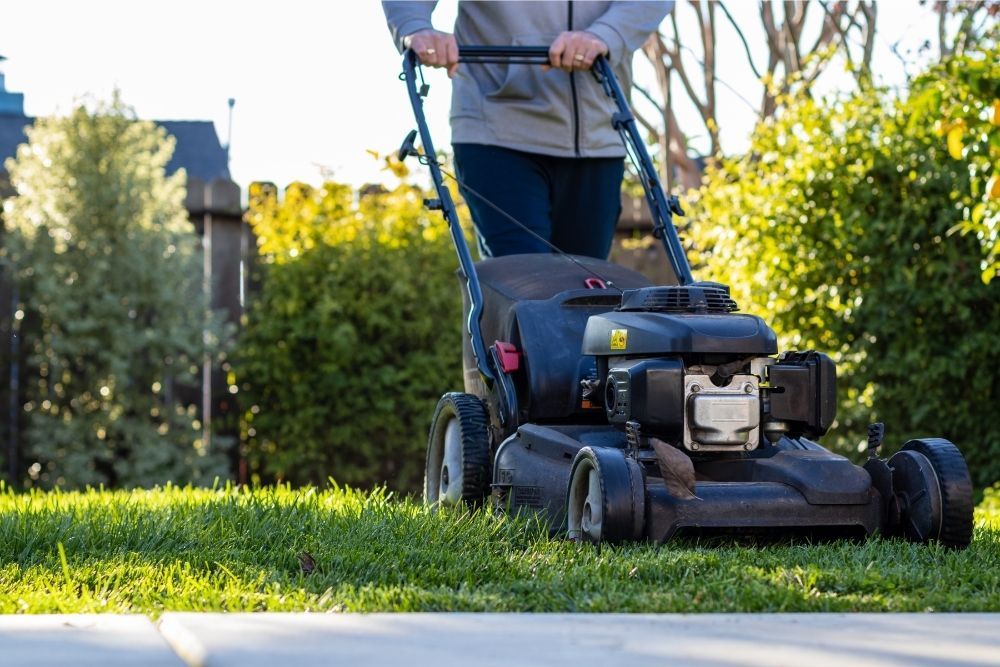
Self-propelled mowers. Pretty self explanatory, right?
Well, whilst the name may be a bit of a giveaway into how these mowers work, there’s still much to discuss. It’s worth knowing a little bit more about exactly how these mowers run, why they’re useful and the different types available on the market.
So, let’s start with the basics.
What Does Self-Propelled Mean?
We all know how ordinary push mowers work. You manually push them forward by the handle. There are no bells, whistles, or swanky technology; it’s just basic mowing.
But with a self-propelled lawn mower, there’s no pushing involved. It has a drive system, separate to the mowing function, that moves the wheels forward. There’s a throttle bar, which you squeeze, and all you need to do is walk at the same pace to steer.
Some self-propelled mowers offer clearly defined speed options. Others will move faster or slower purely based on how much you squeeze the throttle.
We have a whole article on the best self-propelled mowers currently on the market, which goes into more detail about individual mower speeds.
There are five types of self-propelled lawn mower, but more on that later. First, let’s look at how a self-propelled lawn mower could benefit you.
Benefits of a Self-Propelled Lawn Mower
Self-propelled lawn mowers undoubtedly make mowing easier. Here are the four main benefits of using one:
1. Energy Saving
Because self-propelled mowers don’t need to be pushed, you’ll save valuable physical energy. Even if you’ve got a flat garden, the physical strength of pushing a mower (especially a heavy petrol model) can feel like a workout. Not with a self-propelled drive shaft doing the heavy lifting for you, though!
2. Great for Sloping Gardens
Pushing mowers up garden slopes can feel like a herculean feat. If the mower is a heavy model, or the grass collector is full, sloping gardens can make cutting the lawn a dreaded task. Self-propelled lawn mowers essentially take themselves up hills and over uneven ground, so there’s no additional work required, even if your garden resembles an Olympic ski slope (well… within reason!).
3. Ploughs Through Thick Grass
Whereas you need to physically push a traditional mower through thick, long grass, self-propelled models are more like the Pacman of the gardening world. They’re happy to chomp through whatever is in front of them and head towards the next snack.
In part, the mower’s ability to deal with thick grass will depend on its power, but generally speaking self-propelled mowers require less effort to cut through long grass.
4.Time Saving
These lawn mowers are highly efficient, enabling you to mow your lawn quicker than ever before. This saves time for more enjoyable, less mundane garden tasks.
Different Types of Self-Propelled Lawn Mowers
There are five types of self-propelled lawn mower: electric, petrol, front-wheel, rear-wheel, and four-wheel drive. Below, you’ll find information on all of them to assist you in your lawn mower pursuit.
1. Electric
You won’t have to fork out on petrol for this one, but you will have to plug it in to charge it. An electric self-propelled lawn mower can be used often and is easy to start, which can be more challenging with a petrol mower!
The benefits of electric mowers is that they’re quiet, reasonably environmentally friendly and don’t require a lot of maintenance. Nowadays, a lot of mains-powered electric mowers can match smaller petrol mowers on power too. There are a few downsides as well, of course. Mains-powered mowers are restricted by a power cable, and battery-powered cordless mowers are only really suitable for small to medium gardens due to their battery life.
2. Petrol
Petrol mowers can be powerful beasts, a 175cc mower can tear through most overgrown grass without blinking an eye. Don’t believe me? You can check out the reviews of the different petrol mowers we tested – some of them are beasts!
Petrol mowers are easy to use because they cordless and don’t rely on batteries either. Therefore, they’re a good choice for large gardens. Of course, they’re not as environmentally-friendly as electric machines and they can require a fair amount of maintenance.
If you choose a petrol model, there are two different engine types to choose between:
-
Two-Stroke Engine
A two-stroke engine runs at a higher RPM than a four-stroke engine. It has to move quicker to complete the same number of revolutions. As a result, two-stroke engines are noisier. They are generally cheaper than four-stroke engines although no less powerful on a like-for-like basis. When used frequently, two-stroke machines can wear out quicker than four-stroke machines due to the fact that they’re having to work ‘harder’ to achieve the same results.
A two-stroke engine requires a more preparation than a four-stroke engine because you have to measure and mix the engine oil and fuel, rather than putting them in separate compartments.
-
Four-Stroke Engine
As mentioned above, mowers with four-stroke engines are generally more expensive than two-stroke options. You might wonder why people bother buying four-stroke machines then, but a lot of people find them less hassle to use because of the separate compartments for engine oil and fuel. Also, they run quieter than two-stroke machines so put less strain on your relationship with your neighbours…!
3. Front-Wheel Drive
With the front two wheels driving the mower forwards, these mowers can be a little easier to turn than rear-wheel drive. All you need to do is tilt the mower onto its back wheels and pivot. For this reason, some people prefer front-wheel drive mowers for getting around obstacles.
They’re also easier to pull backwards without having to turn everything off or disengage the drive shaft. This is done in a similar way to turning; simply tilt onto the back wheels.
4. Rear-Wheel Drive
Rear-wheel drive mowers offer two different benefits to front-wheel drive machines. Firstly, they work slightly better over hilly ground, which is useful if you’ve got a sloping garden. Secondly, some rear-wheel drive mowers will offer variable speed control. This can be useful when working in smaller areas of the garden. Also, depending on the model, some self-propelled mowers can move a little quickly, so it’s nice to have the option to alter the speed.
5. Four-Wheel Drive
Most four-wheel drive mowers give you the option to use front-wheel drive, rear-wheel drive or four-wheel drive, so you get all the possibilities. As with four-wheel cars, all-wheel drive mowers are great over uneven terrain . They can handle rough ground because the power is evenly distributed across all wheels.
Who Should Buy One?
Anyone can benefit from a self-propelled mower; if a machine can reduce the strain of mowing, that’s certainly cause for celebration in my eyes! However, there are a few considerations to bear in mind when looking for a self-propelled mower.
Primarily, if you’re of an older generation, you may appreciate a self-propelled mower with variable speeds. Some self-propelled mowers can be pretty quick and require a brisk pace to keep up, which might not be for everyone.
Also, if you have a small garden, under 100 m², it may not be worth spending more on a self-propelled mower. Even a hand-push, manual mower is a viable (and low cost!) option for small gardens. If you’d like more advice on what size or type of mower to buy, we’ve written a whole guide on thechoosing the best lawn mower for your garden.
Decision Time: Self-Propelled or Not?
If you’ve got a medium or large garden, a self-propelled mower will dramatically shorten the amount of time you spend mowing.
As long as you take your time choosing the best model for your garden, based on all the information above, you’re sure to be impressed by how much of a difference a little self propulsion makes.
If you have a small garden, or are keen to save money where possible, you might find that a non-propelled model better suits your need. But otherwise, what’re you waiting for! After a couple of goes around your lawn, you’ll wonder how you ever got by without a self-propelled machine!



